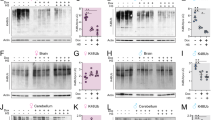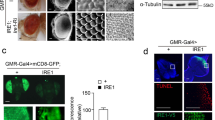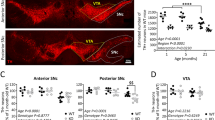Abstract
Amyotrophic lateral sclerosis (ALS) is a fatal, late-onset neurodegenerative disease primarily affecting motor neurons. A unifying feature of many proteins associated with ALS, including TDP-43 and ataxin-2, is that they localize to stress granules. Unexpectedly, we found that genes that modulate stress granules are strong modifiers of TDP-43 toxicity in Saccharomyces cerevisiae and Drosophila melanogaster. eIF2α phosphorylation is upregulated by TDP-43 toxicity in flies, and TDP-43 interacts with a central stress granule component, polyA-binding protein (PABP). In human ALS spinal cord neurons, PABP accumulates abnormally, suggesting that prolonged stress granule dysfunction may contribute to pathogenesis. We investigated the efficacy of a small molecule inhibitor of eIF2α phosphorylation in ALS models. Treatment with this inhibitor mitigated TDP-43 toxicity in flies and mammalian neurons. These findings indicate that the dysfunction induced by prolonged stress granule formation might contribute directly to ALS and that compounds that mitigate this process may represent a novel therapeutic approach.
This is a preview of subscription content, access via your institution
Access options
Subscribe to this journal
Receive 12 print issues and online access
$209.00 per year
only $17.42 per issue
Buy this article
- Purchase on Springer Link
- Instant access to full article PDF
Prices may be subject to local taxes which are calculated during checkout






Similar content being viewed by others
References
Boillée, S., Vande Velde, C. & Cleveland, D.W. ALS: a disease of motor neurons and their nonneuronal neighbors. Neuron 52, 39–59 (2006).
Cleveland, D.W. & Rothstein, J.D. From Charcot to Lou Gehrig: deciphering selective motor neuron death in ALS. Nat. Rev. Neurosci. 2, 806–819 (2001).
Al-Chalabi, A. et al. The genetics and neuropathology of amyotrophic lateral sclerosis. Acta Neuropathol. 124, 339–352 (2012).
Couthouis, J. et al. Evaluating the role of the FUS/TLS-related gene EWSR1 in amyotrophic lateral sclerosis. Hum. Mol. Genet. 21, 2899–2911 (2012).
Couthouis, J. et al. A yeast functional screen predicts new candidate ALS disease genes. Proc. Natl. Acad. Sci. USA 108, 20881–20890 (2011).
Kim, H.J. et al. Mutations in prion-like domains in hnRNPA2B1 and hnRNPA1 cause multisystem proteinopathy and ALS. Nature 495, 467–473 (2013).
King, O.D., Gitler, A.D. & Shorter, J. The tip of the iceberg: RNA-binding proteins with prion-like domains in neurodegenerative disease. Brain Res. 1462, 61–80 (2012).
Warraich, S.T., Yang, S., Nicholson, G.A. & Blair, I.P. TDP-43: a DNA and RNA binding protein with roles in neurodegenerative diseases. Int. J. Biochem. Cell Biol. 42, 1606–1609 (2010).
Aulas, A., Stabile, S. & Vande Velde, C. Endogenous TDP-43, but not FUS, contributes to stress granule assembly via G3BP. Mol. Neurodegener. 7, 54 (2012).
Bentmann, E. et al. Requirements for stress granule recruitment of fused in sarcoma (FUS) and TAR DNA-binding protein of 43 kDa (TDP-43). J. Biol. Chem. 287, 23079–23094 (2012).
Parker, S.J. et al. Endogenous TDP-43 localized to stress granules can subsequently form protein aggregates. Neurochem. Int. 60, 415–424 (2012).
Dewey, C.M. et al. TDP-43 is directed to stress granules by sorbitol, a novel physiological osmotic and oxidative stressor. Mol. Cell Biol. 31, 1098–1108 (2011).
Thomas, M.G., Loschi, M., Desbats, M.A. & Boccaccio, G.L. RNA granules: the good, the bad and the ugly. Cell Signal. 23, 324–334 (2011).
Hart, M.P. & Gitler, A.D. ALS-associated ataxin 2 polyQ expansions enhance stress-induced caspase 3 activation and increase TDP-43 pathological modifications. J. Neurosci. 32, 9133–9142 (2012).
Li, Y.R., King, O.D., Shorter, J. & Gitler, A.D. Stress granules as crucibles of ALS pathogenesis. J. Cell Biol. 201, 361–372 (2013).
Liu-Yesucevitz, L. et al. TAR DNA binding protein-43 (TDP-43) associates with stress granules: analysis of cultured cells and pathological brain tissue. PLoS ONE 5, e13250 (2010).
Wolozin, B. Regulated protein aggregation: stress granules and neurodegeneration. Mol. Neurodegener. 7, 56 (2012).
Bentmann, E., Haass, C. & Dormann, D. Stress granules in neurodegeneration—lessons learnt from TAR DNA binding protein of 43 kDa and fused in sarcoma. FEBS J. 280, 4348–4370 (2013).
Ramaswami, M., Taylor, J.P. & Parker, R. Altered ribostasis: RNA-protein granules in degenerative disorders. Cell 154, 727–736 (2013).
Thomas, M., Alegre-Abarrategui, J. & Wade-Martins, R. RNA dysfunction and aggrephagy at the centre of an amyotrophic lateral sclerosis/frontotemporal dementia disease continuum. Brain 136, 1345–1360 (2013).
Moreno, J.A. et al. Oral treatment targeting the unfolded protein response prevents neurodegeneration and clinical disease in prion-infected mice. Sci. Transl. Med. 5, 206ra138 (2013).
Moreno, J.A. et al. Sustained translational repression by eIF2α-P mediates prion neurodegeneration. Nature 485, 507–511 (2012).
Auluck, P.K., Chan, H.Y., Trojanowski, J.Q., Lee, V.M. & Bonini, N.M. Chaperone suppression of α-synuclein toxicity in a Drosophila model for Parkinson's disease. Science 295, 865–868 (2002).
Cooper, A.A. et al. α-Synuclein blocks ER-Golgi traffic and Rab1 rescues neuron loss in Parkinson's models. Science 313, 324–328 (2006).
Elden, A.C. et al. Ataxin-2 intermediate-length polyglutamine expansions are associated with increased risk for ALS. Nature 466, 1069–1075 (2010).
Gitler, A.D. et al. α-Synuclein is part of a diverse and highly conserved interaction network that includes PARK9 and manganese toxicity. Nat. Genet. 41, 308–315 (2009).
Outeiro, T.F. & Lindquist, S. Yeast cells provide insight into α-synuclein biology and pathobiology. Science 302, 1772–1775 (2003).
Treusch, S. et al. Functional links between Aβ toxicity, endocytic trafficking, and Alzheimer's disease risk factors in yeast. Science 334, 1241–1245 (2011).
Johnson, B.S., McCaffery, J.M., Lindquist, S. & Gitler, A.D. A yeast TDP-43 proteinopathy model: exploring the molecular determinants of TDP-43 aggregation and cellular toxicity. Proc. Natl. Acad. Sci. USA 105, 6439–6444 (2008).
Johnson, B.S. et al. TDP-43 is intrinsically aggregation-prone, and amyotrophic lateral sclerosis–linked mutations accelerate aggregation and increase toxicity. J. Biol. Chem. 284, 20329–20339 (2009).
Armakola, M., Hart, M.P. & Gitler, A.D. TDP-43 toxicity in yeast. Methods 53, 238–245 (2011).
Hu, X.H. et al. Genetic dissection of ethanol tolerance in the budding yeast Saccharomyces cerevisiae. Genetics 175, 1479–1487 (2007).
Sun, Z. et al. Molecular determinants and genetic modifiers of aggregation and toxicity for the ALS disease protein FUS/TLS. PLoS Biol. 9, e1000614 (2011).
Jain, S. & Parker, R. The discovery and analysis of P bodies. Adv. Exp. Med. Biol. 768, 23–43 (2013).
Lagier-Tourenne, C., Polymenidou, M. & Cleveland, D.W. TDP-43 and FUS/TLS: emerging roles in RNA processing and neurodegeneration. Hum. Mol. Genet. 19, R46–R64 (2010).
Ling, S.C., Polymenidou, M. & Cleveland, D.W. Converging mechanisms in ALS and FTD: disrupted RNA and protein homeostasis. Neuron 79, 416–438 (2013).
Tazen, S. et al. Amyotrophic lateral sclerosis and spinocerebellar ataxia type 2 in a family with full CAG repeat expansions of ATXN2. JAMA Neurol. doi:10.1001/jamaneurol.2013.443 (19 August 2013).
Zoll, W.L., Horton, L.E., Komar, A.A., Hensold, J.O. & Merrick, W.C. Characterization of mammalian eIF2A and identification of the yeast homolog. J. Biol. Chem. 277, 37079–37087 (2002).
Dewey, C.M. et al. TDP-43 aggregation in neurodegeneration: are stress granules the key? Brain Res. 1462, 16–25 (2012).
Anderson, P. & Kedersha, N. Visibly stressed: the role of eIF2, TIA-1, and stress granules in protein translation. Cell Stress Chaperones 7, 213–221 (2002).
Brand, S. & Bourbon, H.M. The developmentally-regulated Drosophila gene rox8 encodes an RRM-type RNA binding protein structurally related to human TIA-1–type nucleolysins. Nucleic Acids Res. 21, 3699–3704 (1993).
Dalton, L.E., Healey, E., Irving, J. & Marciniak, S.J. Phosphoproteins in stress-induced disease. Prog. Mol. Biol. Transl. Sci. 106, 189–221 (2012).
Khong, A. & Jan, E. Modulation of stress granules and P bodies during dicistrovirus infection. J. Virol. 85, 1439–1451 (2011).
Kimball, S.R., Horetsky, R.L., Ron, D., Jefferson, L.S. & Harding, H.P. Mammalian stress granules represent sites of accumulation of stalled translation initiation complexes. Am. J. Physiol. Cell Physiol. 284, C273–C284 (2003).
Kedersha, N. et al. Dynamic shuttling of TIA-1 accompanies the recruitment of mRNA to mammalian stress granules. J. Cell Biol. 151, 1257–1268 (2000).
Ruggieri, A. et al. Dynamic oscillation of translation and stress granule formation mark the cellular response to virus infection. Cell Host Microbe 12, 71–85 (2012).
Nonhoff, U. et al. Ataxin-2 interacts with the DEAD/H-box RNA helicase DDX6 and interferes with P-bodies and stress granules. Mol. Biol. Cell 18, 1385–1396 (2007).
Swisher, K.D. & Parker, R. Localization to, and effects of Pbp1, Pbp4, Lsm12, Dhh1, and Pab1 on stress granules in Saccharomyces cerevisiae. PLoS ONE 5, e10006 (2010).
Kozlov, G., Menade, M., Rosenauer, A., Nguyen, L. & Gehring, K. Molecular determinants of PAM2 recognition by the MLLE domain of poly(A)-binding protein. J. Mol. Biol. 397, 397–407 (2010).
Chowdhury, A., Raju, K.K., Kalurupalle, S. & Tharun, S. Both Sm-domain and C-terminal extension of Lsm1 are important for the RNA-binding activity of the Lsm1–7-Pat1 complex. RNA 18, 936–944 (2012).
Satterfield, T.F. & Pallanck, L.J. Ataxin-2 and its Drosophila homolog, ATX2, physically assemble with polyribosomes. Hum. Mol. Genet. 15, 2523–2532 (2006).
Buratti, E. & Baralle, F.E. Characterization and functional implications of the RNA binding properties of nuclear factor TDP-43, a novel splicing regulator of CFTR exon 9. J. Biol. Chem. 276, 36337–36343 (2001).
Axten, J.M. et al. Discovery of 7-methyl-5-(1-{[3-(trifluoromethyl)phenyl]acetyl}-2,3-dihydro-1H-indol-5-yl)-7H-pyrrolo[2,3-d]pyrimidin-4-amine (GSK2606414), a potent and selective first-in-class inhibitor of protein kinase R (PKR)-like endoplasmic reticulum kinase (PERK). J. Med. Chem. 55, 7193–7207 (2012).
Arrasate, M., Mitra, S., Schweitzer, E.S., Segal, M.R. & Finkbeiner, S. Inclusion body formation reduces levels of mutant huntingtin and the risk of neuronal death. Nature 431, 805–810 (2004).
Barmada, S.J. et al. Cytoplasmic mislocalization of TDP-43 is toxic to neurons and enhanced by a mutation associated with familial amyotrophic lateral sclerosis. J. Neurosci. 30, 639–649 (2010).
Zuberi, K. et al. GeneMANIA prediction server 2013 update. Nucleic Acids Res. 41, W115–W122 (2013).
Hofmann, S., Cherkasova, V., Bankhead, P., Bukau, B. & Stoecklin, G. Translation suppression promotes stress granule formation and cell survival in response to cold shock. Mol. Biol. Cell 23, 3786–3800 (2012).
Buchan, J.R., Yoon, J.H. & Parker, R. Stress-specific composition, assembly and kinetics of stress granules in Saccharomyces cerevisiae. J. Cell Sci. 124, 228–239 (2011).
Hekmat-Scafe, D.S., Dang, K.N. & Tanouye, M.A. Seizure suppression by gain-of-function escargot mutations. Genetics 169, 1477–1493 (2005).
Brand, A.H. & Perrimon, N. Targeted gene expression as a means of altering cell fates and generating dominant phenotypes. Development 118, 401–415 (1993).
Pfeiffer, B.D. et al. Refinement of tools for targeted gene expression in Drosophila. Genetics 186, 735–755 (2010).
Feany, M.B. & Bender, W.W. A Drosophila model of Parkinson's disease. Nature 404, 394–398 (2000).
Arrasate, M. & Finkbeiner, S. Automated microscope system for determining factors that predict neuronal fate. Proc. Natl. Acad. Sci. USA 102, 3840–3845 (2005).
Acknowledgements
We thank X. Teng and Y. Zhu for technical assistance and W. Motley, A. Berson and other laboratory members for insightful comments. This work was funded by grants from the Howard Hughes Medical Institute (N.M.B.), grant R01NS073660 from the US National Institutes of Health (NIH; A.D.G. and N.M.B.), NIH Director's New Innovator Award DP2OD004417 (A.D.G.) and US NIH grant R01NS065317 (A.D.G.), the Robert Packard Center for ALS and the Williams H. Adams Foundation (S.F.), and US NIH grants AG10124, AG32953, AG17586 and NS53488 (J.Q.T. and V.M.-Y.L.). A.D.G. and S.F. are supported by a grant from Target ALS. A.R.R. is supported by a BrightFocus Alzheimer's disease research grant.
Author information
Authors and Affiliations
Contributions
H.-J.K., A.R.R., E.S.L., L.M. and A.D.G. conceived, designed and performed experiments, performed statistical analysis and analyzed data. R.A.W. performed experiments. J.Q.T. and V.M.-Y.L. contributed reagents and materials and provided experimental input. S.F., A.D.G. and N.M.B. conceived and designed experiments, analyzed data and supervised the research. H.-J.K. and N.M.B., with input from A.R.R. and A.D.G., wrote the manuscript.
Corresponding author
Ethics declarations
Competing interests
A.D.G. is an inventor on patents and patent applications for the gene hits from the yeast genetic screen that have been licensed to FoldRx.
Supplementary information
Supplementary Text and Figures
Supplementary Figures 1–5 and Supplementary Tables 1–3 (PDF 5710 kb)
Rights and permissions
About this article
Cite this article
Kim, HJ., Raphael, A., LaDow, E. et al. Therapeutic modulation of eIF2α phosphorylation rescues TDP-43 toxicity in amyotrophic lateral sclerosis disease models. Nat Genet 46, 152–160 (2014). https://doi.org/10.1038/ng.2853
Received:
Accepted:
Published:
Issue Date:
DOI: https://doi.org/10.1038/ng.2853
This article is cited by
-
Saturated fatty acids entrap PDX1 in stress granules and impede islet beta cell function
Diabetologia (2021)
-
DDX17 is involved in DNA damage repair and modifies FUS toxicity in an RGG-domain dependent manner
Acta Neuropathologica (2021)
-
Variant in NHLRC2 leads to increased hnRNP C2 in developing neurons and the hippocampus of a mouse model of FINCA disease
Molecular Medicine (2020)
-
Fine tuning of the unfolded protein response by ISRIB improves neuronal survival in a model of amyotrophic lateral sclerosis
Cell Death & Disease (2020)
-
Aberrant deposition of stress granule-resident proteins linked to C9orf72-associated TDP-43 proteinopathy
Molecular Neurodegeneration (2019)



